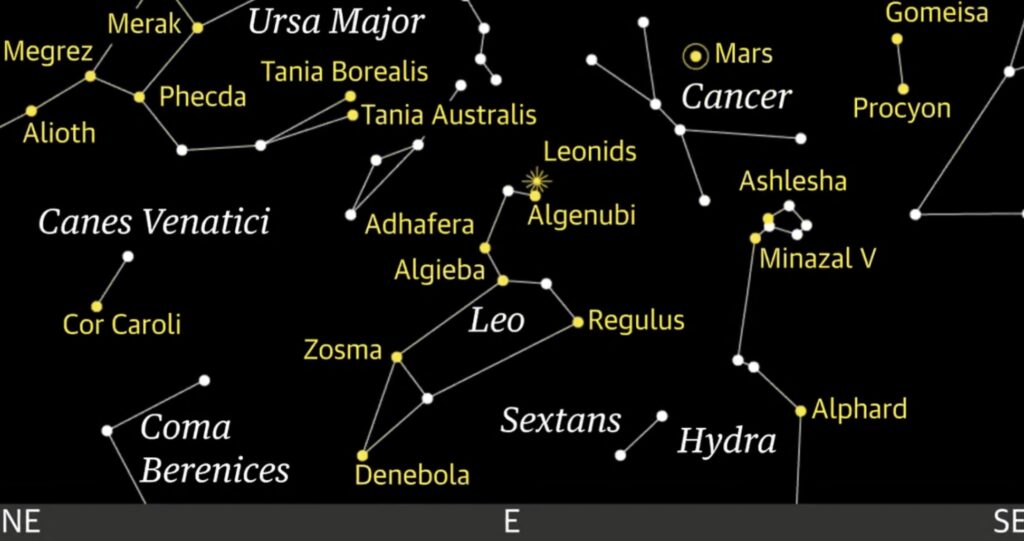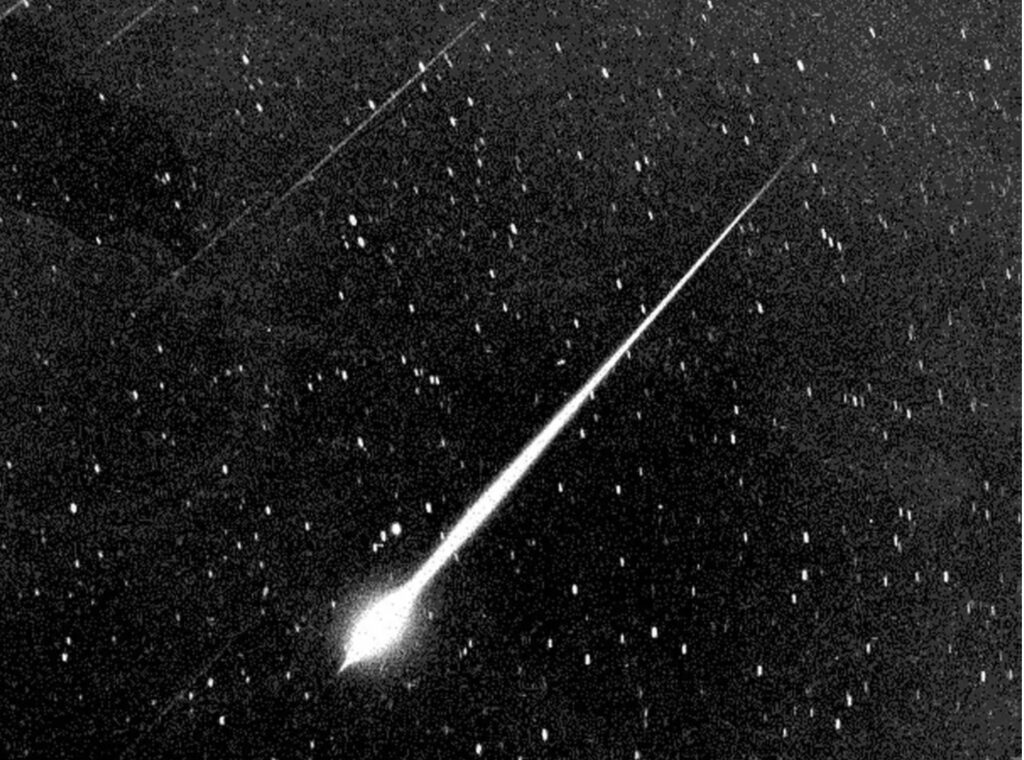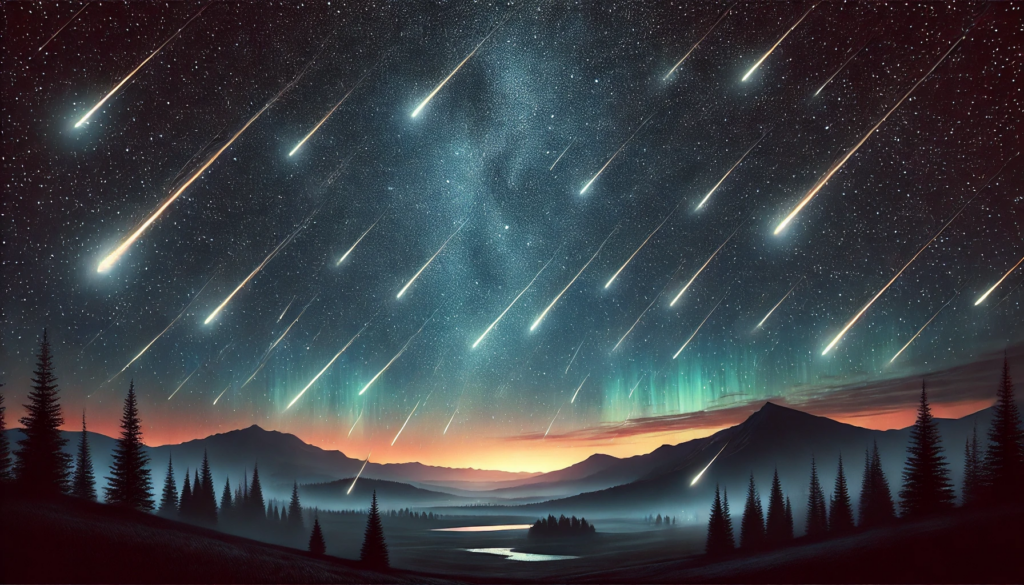ChatGPT:
The Leonid meteor shower is a prominent annual astronomical event that typically occurs each November, peaking around the 17th or 18th of the month. Named after the constellation Leo, from which the meteors appear to radiate, the Leonids are renowned for their spectacular displays and occasional meteor storms.
Origin
The Leonid meteor shower originates from Comet 55P/Tempel-Tuttle, a periodic comet with an orbital period of approximately 33 years. As Comet Tempel-Tuttle travels through the inner solar system, it sheds particles of dust, ice, and small rocky debris—collectively known as meteoroids—along its orbital path. This trail of debris forms a meteoroid stream that the Earth intersects annually.
When the Earth passes through this stream, the meteoroids enter our atmosphere at incredibly high speeds, about 71 kilometers per second (approximately 44 miles per second). The friction with atmospheric gases causes them to heat up and disintegrate, creating bright streaks of light known as meteors.
Meteor Storms and Activity Peaks
While the Leonids produce a modest number of meteors most years—typically around 15 meteors per hour—they are famous for producing meteor storms roughly every 33 years, coinciding with the comet’s return to the inner solar system. During these storms, meteor rates can soar into the thousands per hour. Notable storms occurred in:
• 1833: One of the most spectacular meteor storms ever recorded, with rates estimated at up to 100,000 meteors per hour.
• 1866, 1966, 1999, and 2001: Subsequent storms provided dazzling displays, though none matched the intensity of the 1833 event.
Orbits and “Circles”
The term “circles” likely refers to the orbital paths of both Comet Tempel-Tuttle and the Earth, as well as the distribution of meteoroid streams in space.
• Comet Tempel-Tuttle’s Orbit: The comet follows an elongated elliptical orbit around the Sun, bringing it close to Earth’s orbit every 33 years. Its path intersects Earth’s orbit at the same points annually, leading to the recurring meteor shower.
• Meteoroid Streams: Over time, the debris from the comet spreads along its orbital path, creating dense and sparse regions within the meteoroid stream. When Earth passes through a denser clump of debris, we experience a higher rate of meteors.
• Earth’s Intersection with the Stream: The Earth crosses the comet’s orbital plane at approximately the same time each year. This intersection point is why the Leonid meteor shower is an annual event.
Observation Tips
• Best Time to View: The optimal time to observe the Leonids is after midnight local time, when the radiant point in Leo rises higher in the sky.
• Viewing Conditions: For the best experience, find a dark location away from city lights with a clear, unobstructed view of the sky.
• No Equipment Needed: Meteors are best observed with the naked eye, as telescopes or binoculars limit your field of view.
Significance
The Leonid meteor shower offers both amateur and professional astronomers valuable insights into the behavior of cometary debris and the dynamics of meteoroid streams. Studying the Leonids helps scientists understand:
• Comet Composition and Decay: Analyzing meteors provides information about the materials that make up comets.
• Orbital Mechanics: Observing the timing and intensity of meteor showers aids in mapping the orbits of meteoroid streams and predicting future activity.
• Atmospheric Interactions: Meteors serve as natural probes for studying the Earth’s upper atmosphere, including chemical compositions and wind patterns.
Conclusion
The Leonid meteor shower is a captivating celestial phenomenon rooted in the interplay between Comet Tempel-Tuttle’s orbit and Earth’s annual journey around the Sun. Its origin lies in the comet’s debris trail, and its spectacular displays are a direct result of Earth’s passage through this stream of meteoroids. The “circles” or orbits of both celestial bodies create a predictable yet ever-changing spectacle that continues to fascinate observers around the world.
Remember to mark your calendar for the next Leonid meteor shower and take a moment to look up at the night sky. You might just witness a piece of cosmic history streaking overhead.

Observing the Leonid Meteor Shower During a Full Moon
This year, the peak of the Leonid meteor shower coincides with a full moon, which can make viewing meteors more challenging due to increased sky brightness. However, with some strategic planning, you can still enjoy the celestial display. Here are some tips to help you observe the meteors under bright conditions:
1. Choose the Right Location
• Find a Dark Site: Seek out the darkest possible location, far from city lights and other sources of light pollution. Rural areas, high elevations, or designated dark-sky parks are ideal.
• Use Natural Barriers: Position yourself so that the moon is blocked by natural features like mountains, hills, or tall trees. This can reduce the moon’s glare in your immediate field of view.
2. Adjust Your Timing
• Observe During Moonset or Moonrise: While a full moon stays in the sky for most of the night, there may be brief periods when it’s low on the horizon. Check local moonrise and moonset times to find windows of reduced brightness.
• Extend Your Viewing Period: Consider observing on the nights before and after the peak. Meteor activity may be slightly lower, but the moon’s position might offer better viewing conditions.
3. Optimize Your Viewing Strategy
• Look Away from the Moon: Focus your attention on the darkest part of the sky, opposite the moon. Meteors can appear anywhere, so looking away from the moon increases your chances of spotting them.
• Use Peripheral Vision: Meteors are often more visible when not looked at directly. Relax your eyes and use your peripheral vision to catch faint streaks of light.
4. Adapt Your Eyes to the Darkness
• Avoid Artificial Light: Minimize exposure to other light sources such as phone screens, flashlights, or car headlights. If you need light, use a red-filtered flashlight to preserve your night vision.
• Allow Time for Adjustment: Give your eyes at least 20–30 minutes to adapt to the darkness. This enhances your ability to see fainter meteors.
5. Be Patient and Comfortable
• Dress Appropriately: Wear warm clothing and consider bringing blankets or sleeping bags, especially if you’re observing in the early morning hours.
• Use Comfortable Seating: A reclining chair or ground pad allows you to comfortably gaze upward without straining your neck.
• Stay Patient: Meteor watching can require patience, especially under less-than-ideal conditions. Relax and enjoy the experience of being under the night sky.
6. Manage Expectations
• Anticipate Lower Meteor Counts: The moon’s brightness will outshine fainter meteors, so you may see fewer meteors than in darker conditions.
• Appreciate Bright Meteors: While the overall number may be reduced, the Leonids are known for producing bright, fast-moving meteors that can still be visible despite moonlight.
7. Use Technology Wisely
• Astronomy Apps: Utilize mobile apps to track the radiant point of the Leonids in the constellation Leo and to check real-time meteor activity.
• Stay Informed: Keep an eye on weather forecasts and astronomical updates to choose the best possible night for observation.
8. Consider Alternate Viewing Options
• Join Local Events: Astronomy clubs or observatories may host meteor shower viewings with equipment and expertise that can enhance your experience.
• Online Viewing: If conditions are too challenging, consider watching live streams of the meteor shower provided by reputable astronomical organizations.
9. Photography Tips (Optional)
If you’re interested in photographing the meteor shower:
• Use Long Exposures: Set up a camera on a tripod with long exposure settings to capture meteors that may not be visible to the naked eye.
• Adjust ISO and Aperture: Optimize your camera settings for low-light conditions, keeping in mind that the full moon will illuminate the sky.
Conclusion
While a full moon can make meteor watching more challenging, it doesn’t have to spoil the experience. By selecting a strategic location, adjusting your viewing habits, and managing expectations, you can still witness some of the Leonid meteors. Remember that meteor showers are not just about the meteors themselves but also about enjoying the beauty and tranquility of the night sky.
Wishing you clear skies and successful meteor spotting! Don’t forget to dress warmly and perhaps bring along a warm beverage to enhance your stargazing experience.

First Recorded Occurrence of the Leonid Meteor Shower
The earliest known recorded occurrence of the Leonid meteor shower dates back to AD 902. Chinese astronomers documented a significant meteor display during this year. Historical texts describe “stars that fell like rain,” which is characteristic of a meteor shower emanating from the constellation Leo.
Subsequent Early Records:
• AD 934: Chinese records again mention a meteor shower that is believed to be the Leonids.
• AD 1002: Observations in East Asian chronicles note meteor activity consistent with the Leonid meteor shower.
• AD 1202: Medieval European documents record a meteor display that aligns with the timing of the Leonids.
• AD 1366: Korean and Chinese astronomers observed a notable meteor shower, likely the Leonids.
• AD 1799: A significant Leonid meteor storm was observed across Europe and the Americas, marking one of the first well-documented instances in the Western world.
Notable Event:
• 1833 Meteor Storm: While not the first recorded occurrence, the 1833 Leonid meteor storm is one of the most famous. Witnesses reported rates of up to 100,000 meteors per hour. This event was pivotal in the scientific study of meteor showers, leading to the realization that they are associated with cometary debris.
Summary
The first recorded occurrence of the Leonid meteor shower is attributed to AD 902, based on Chinese astronomical records. These early observations have been crucial in understanding the periodic nature of the Leonids and their connection to Comet Tempel-Tuttle.

